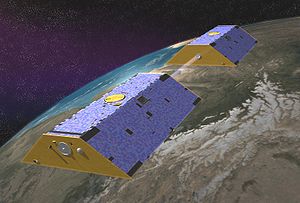Gravity Recovery and Climate Experiment
- Gravity Recovery and Climate Experiment
-
Gravity Recovery and Climate Experiment (GRACE, Experimento de Clima y Recuperación Gravitatoria) es una misión espacial conjunta entre la NASA y la Agencia Espacial de Alemania cuyo objetivo es cartografiar con precisión el campo gravitatorio terrestre. Fue lanzada el 17 de marzo de 2002 desde el cosmódromo de Plesetsk a bordo de un cohete Rockot.
La misión consta de dos naves idénticas (apodadas "Tom y Jerry") volando en formación a una distancia de unos 220 km entre ellas, en una órbita polar a 500 km de la superficie terrestre. Las variaciones en el campo gravitatorio terrestre, debidas a las diferentes distribuciones de masa en la superficie terrestre, producen pequeñas variaciones en la distancia entre ambas naves, que son medidas gracias al uso de GPS y a un sistema de transmisión de señales de microondas entre las naves.
Los resultados de GRACE incluyen la medición de las variaciones debidas a las corrientes oceánicas y los acuíferos, variaciones en la capa de hielo y variaciones de masa de la corteza terrestre, ayudando a comprender tanto las variaciones del clima como fenómenos geológicos.
Referencias
- Wade, Mark (2008). «GRACE» (en inglés). Consultado el 24 de septiembre de 2008.
Enlaces externos
Categorías: - Satélites artificiales lanzados en 2002
- Satélites de observación terrestre
Wikimedia foundation.
2010.
Mira otros diccionarios:
Gravity Recovery and Climate Experiment — Les deux satellites GRACE (vue d artiste) Gravity Recovery And Climate Experiment (GRACE) est une mission spatiale conjointe de la NASA et de l agence spatiale allemande lancée en mars 2002 et destinée à effectuer des mesures détaillées de la… … Wikipédia en Français
Gravity Recovery and Climate Experiment — The goal of the Gravity Recovery And Climate Experiment (GRACE) space mission is to obtain accurate global and high resolution determination of both the static and the time variable components of the Earth s gravity field. GRACE is intended to… … Wikipedia
Gravity Recovery and Climate Experiment — GRACE Typ: Forschungssatellit Land (Organisation): USA/Deutschland (NASA/DLR) NSSDC ID: 2002 012A/B Missionsdaten Trägerrakete … Deutsch Wikipedia
Gravity Recovery And Climate Experiment — GRACE Typ: Forschungssatellit Land: USA/Deutschland Behörde: NASA/DLR NS … Deutsch Wikipedia
Gravity Recovery and Interior Laboratory — (GRAIL) Gravity Recovery and Interior Laboratory … Википедия
Gravity Recovery and Interior Laboratory — For other uses, see Grail (disambiguation). Gravity Recovery and Interior Laboratory (GRAIL) Artist s interpretation of the GRAIL tandem spacecraft above the lunar surface Operator NASA / JPL Major contractors … Wikipedia
Gravity Field and Steady-State Ocean Circulation Explorer — The Gravity Field and Steady State Ocean Circulation Explorer (GOCE) is an ESA satellite to be launched 27 October 2008 at 15:21 CET [cite web|url=http://www.esa.int/SPECIALS/GOCE/SEMRGH6EJLF 0.html|title=GOCE team gearing up for new launch… … Wikipedia
Constellation Observing System for Meteorology, Ionosphere, and Climate — COSMIC Operator COSMIC Major contractors Orbital Sciences Corporation Mission type Meteorology, Ionosphere, Climatology, and … Wikipedia
Climate of Antarctica — Surface temperature of Antarctica in winter and summer The climate of Antarctica is the coldest on the whole of Earth. Antarctica has the lowest naturally occurring temperature ever recorded on the ground on Earth: −89.2 °C (−128.6 °F)… … Wikipedia
Mathematics and Physical Sciences — ▪ 2003 Introduction Mathematics Mathematics in 2002 was marked by two discoveries in number theory. The first may have practical implications; the second satisfied a 150 year old curiosity. Computer scientist Manindra Agrawal of the… … Universalium

